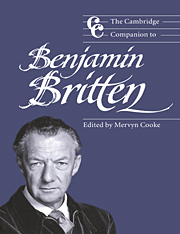Book contents
- Frontmatter
- Introduction
- Part one Apprenticeship
- 1 Juvenilia (1922–1932)
- 2 Britten, Auden and ‘otherness’
- 3 Britten in the cinema: Coal Face
- Part two The operas
- 4 ‘He descended into Hell’: Peter Grimes, Ellen Orford and salvation denied
- 5 The chamber operas
- 6 Gloriana: Britten's ‘slighted child’
- 7 Britten and Shakespeare: A Midsummer Night's Dream
- 8 Eros in life and death: Billy Budd and Death in Venice
- Part three Perspectives
- Part four The composer in the community
- Notes
- Index of Britten's works
- General index
4 - ‘He descended into Hell’: Peter Grimes, Ellen Orford and salvation denied
from Part two - The operas
Published online by Cambridge University Press: 28 September 2011
- Frontmatter
- Introduction
- Part one Apprenticeship
- 1 Juvenilia (1922–1932)
- 2 Britten, Auden and ‘otherness’
- 3 Britten in the cinema: Coal Face
- Part two The operas
- 4 ‘He descended into Hell’: Peter Grimes, Ellen Orford and salvation denied
- 5 The chamber operas
- 6 Gloriana: Britten's ‘slighted child’
- 7 Britten and Shakespeare: A Midsummer Night's Dream
- 8 Eros in life and death: Billy Budd and Death in Venice
- Part three Perspectives
- Part four The composer in the community
- Notes
- Index of Britten's works
- General index
Summary
In his introduction to the original production of Peter Grimes in 1945, Britten stated: ‘I wanted to express my awareness of the perpetual struggle of men and women whose livelihood depends on the sea – difficult though it is to treat such a universal subject in theatrical form.’ Pears stated that ‘Ben and I had imagined the sea as being in the orchestra so it was not necessary to see it on stage.’ If the ‘sea’ can be understood almost as another operatic character, it becomes so primarily through its symbolic representation of human emotions; it may be seen to have the potential for providing a commentary on the dramatic action, mediating between it and the audience. This function is clearly to be seen in the six orchestral interludes that punctuate the opera, two located in each of the three acts. It is essential to distinguish between Britten's specifically programmatic designation of four of these as ‘Sea Interludes’ (‘Dawn’, ‘Sunday Morning’, ‘Moonlight’ and ‘Storm’) for the purposes of creating a concert-hall orchestral suite, and their greater psychological and narrative import – undesignated beyond the generic title ‘Interlude’ – in the operatic context.
Britten's ‘sea’ may, in fact, be read as a metaphor of Peter Grimes himself. A great deal of ink has been spilt in the fifty years since the opera's premiere by critics and scholars wrestling to understand the ‘divided’ character of Britten's Grimes. The unresolved ambiguities of his character only begin to become explicable when he is understood as an incarnation of the dualism at the core of Britten's musical personality.
- Type
- Chapter
- Information
- The Cambridge Companion to Benjamin Britten , pp. 79 - 94Publisher: Cambridge University PressPrint publication year: 1999

